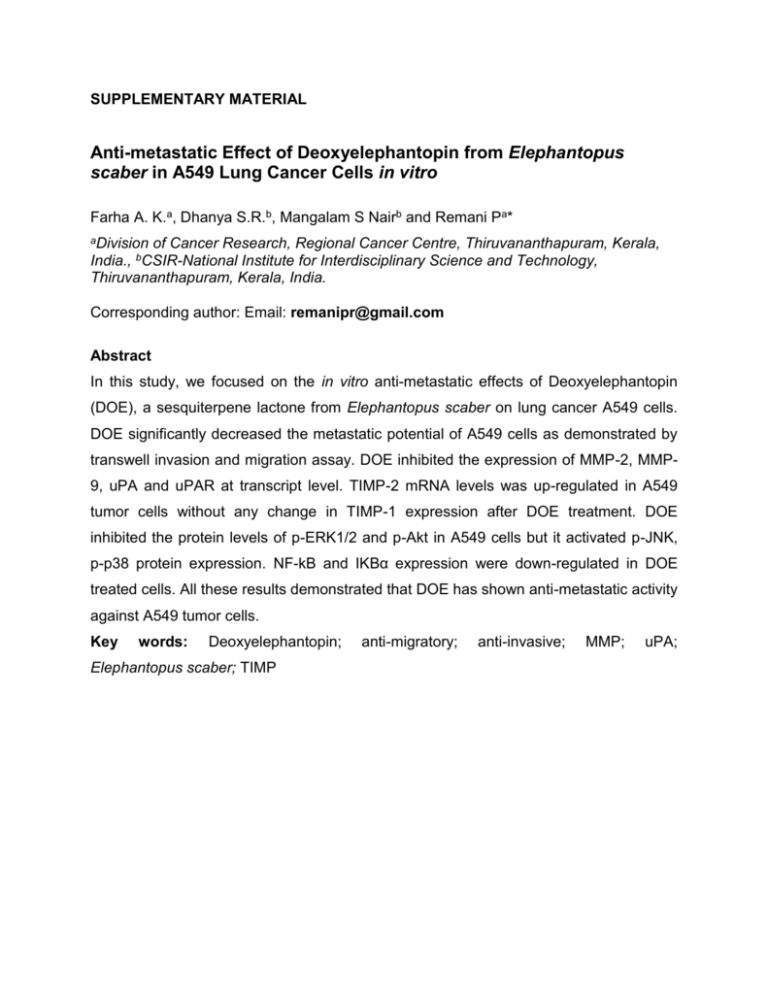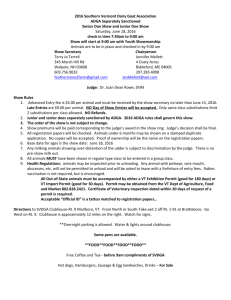Anti-metastatic Effect of Deoxyelephantopin from Elephantopus
advertisement

SUPPLEMENTARY MATERIAL Anti-metastatic Effect of Deoxyelephantopin from Elephantopus scaber in A549 Lung Cancer Cells in vitro Farha A. K.a, Dhanya S.R.b, Mangalam S Nairb and Remani Pa* aDivision of Cancer Research, Regional Cancer Centre, Thiruvananthapuram, Kerala, India., bCSIR-National Institute for Interdisciplinary Science and Technology, Thiruvananthapuram, Kerala, India. Corresponding author: Email: remanipr@gmail.com Abstract In this study, we focused on the in vitro anti-metastatic effects of Deoxyelephantopin (DOE), a sesquiterpene lactone from Elephantopus scaber on lung cancer A549 cells. DOE significantly decreased the metastatic potential of A549 cells as demonstrated by transwell invasion and migration assay. DOE inhibited the expression of MMP-2, MMP9, uPA and uPAR at transcript level. TIMP-2 mRNA levels was up-regulated in A549 tumor cells without any change in TIMP-1 expression after DOE treatment. DOE inhibited the protein levels of p-ERK1/2 and p-Akt in A549 cells but it activated p-JNK, p-p38 protein expression. NF-kB and IKBα expression were down-regulated in DOE treated cells. All these results demonstrated that DOE has shown anti-metastatic activity against A549 tumor cells. Key words: Deoxyelephantopin; Elephantopus scaber; TIMP anti-migratory; anti-invasive; MMP; uPA; Experimental Chemicals and reagents Dulbecco’s Modified Eagles Medium (DMEM), 1X antibiotic-antimycotic solution, Ready Mix Taq PCR reaction mix, ethidium bromide and crystal violet were obtained from Sigma-Aldrich (USA). Fetal bovine serum (FBS) was purchased from Pan Biotech (Germany). Antibodies ERK1/2, p- ERK1/2, JNK, p-JNK, p38, p-p8, Akt, p-Akt and βactin were procured from Cell Signaling Technology (USA). Isolation of Deoxyelephantopin from E. scaber E. scaber was collected from Trivandrum district in Kerala, India. A voucher specimen (TBGT-25419) was deposited in the herbarium of Jawaharlal Nehru Tropical Botanical Garden and Research Institute (JNTBGRI), Palode, Trivandrum. E. scaber as whole plant was extracted using chloroform at room temperature and solvent was completely removed under vacuum. DOE (Figure 1) was isolated via fractionation of E. scaber chloroform extract as previously described (Geetha et al. 2011). A stock solution of DOE was prepared in DMSO (1mg/ml), and stored at -200C. Before use, the solution was freshly prepared by diluting with DMEM to the desired concentration. In order to evaluate the effects of DOE on the metastatic activity of A549 cells, it was necessary to choose a non-toxic effective dose. We have previously reported that DOE exhibited antitumor effects on A549 cells with an IC50 value of 12.28 µg/ml DOE at 48 h of incubation (Kabeer et al., 2013). For all experiments, the concentration used was 12.28 µg/ml DOE. IC50 value at 48 h incubation was chosen for subsequent experiments since the viability of cells remained above 70% when the cells were treated at this dose for 24 h. The maximum incubation time for most of the anti-metastatic assays was only up to 24 h. Final concentration of DMSO used in treated group was 0.6%. The above concentration of DMSO did not affect the viability of A549 cells. Cell culture and maintenance The lung cancer cell line A549 was obtained from National Centre for Cell Sciences (NCCS), Pune, India. Cells were grown in DMEM supplemented with 10% FBS and 1X antibiotic-antimycotic solution and maintained at 37 0C in a humidified atmosphere containing 5% CO2. In vitro wound closure assay A549 cells were seeded in 6-well plate and incubated to attain 80% confluence. An injury line was made with a pipette tip on cell monolayer and washed with PBS to remove floating cells. The cells were then treated with DOE and incubated for 48 h. The scratched area was photographed in different time intervals (0, 24 and 48 h) in 3 randomly selected fields (100X magnifications) in 3 independent experiments. Migration assay A549 cells (5x104) were seeded in transwell chamber (BD Biosciences, USA) with or without DOE. DMEM containing 10% FBS was placed in the bottom chamber as chemoattractant. The plates were incubated at 370C for 24 h. Migration was assessed after removing non-migrating cells from the upper chamber using a cotton swab. Cells on the bottom of the filter were stained with 0.5% crystal violet for 10 min and counted (three fields of each triplicate filter) using an inverted microscope (Olympus 1X51, Japan). In vitro invasion assay Matrigel invasion assays were performed using 24-well BD BiocoatTMMatrigel Invasion Chamber (BD Biosciences, USA). The matrigel coated filters were rehydrated by adding DMEM and kept in a humidified incubator at 370C and 5% CO2 for 2 h. The medium was removed after rehydration. Cells (2.5x104/0.5ml) treated with or without indicated concentration of DOE were placed in the upper part of the transwell chamber and incubated for 24 h at 370C. DMEM containing 10% FBS was placed in the lower chamber as chemoattractant. The non–invading cells on the upper chamber were removed by scrubbing with cotton swabs. The cells that invaded to the lower surface of the membrane were fixed with methanol and stained with 0.5% crystal violet in 25% methanol for 10 min. The number of invaded cells was counted under light microscope in 3 randomly selected fields (400X magnification). RNA extraction and Reverse Transcription-PCR Total RNA was extracted from A549 cells using TRI Reagent (Sigma-Aldrich, USA) according to the manufacture’s protocol. The RNA was checked qualitatively by electrophoresis in 2% agarose gel and quantitatively by spectrophotometry. For RTPCR, cDNA was synthesized from 1µg of total RNA using High capacity cDNA reverse transcription kit (Applied Biosystem, USA) according to the manufacturer’s protocol. The cDNA was amplified by PCR with the following primers (Table.S1). PCR products were analysed by agarose gel electrophoresis stained with ethidium bromide. Western Blotting A549 cells (106) were treated with DOE for 48 h and total cell lysates were prepared. Protein samples (50 μg) were separated on 8% SDS-PAGE and transferred onto a PVDF membrane (Millipore, India). The membranes were blocked with 5% BSA in PBS containing 0.1% Tween 20 for 1 h and then incubated with primary antibodies (ERK1/2, p-ERK1/2, JNK, p-JNK, p38, p-p38, Akt, p-Akt and β-actin) overnight at 40C. After washing with TBST, the membranes were incubated with HRP-conjugated secondary antibody for 2 h and specific proteins were detected by enhanced chemiluminescence detection kit (Thermo scientific, USA). Statistical analysis Data were expressed as mean ± standard deviation. Student's t-test was used to determine the level of significance at P <0.05. References Chen R, Xue J, Xie M. 2013.Osthole regulates TGF-β1 and MMP-2/9 expressions via activation of PPARα/γ in cultured mouse cardiac fibroblasts stimulated with angiotensin II. J Pharm Pharm Sci. 16(5): 732-741. Choo EJ, Rhee YH, Jeong SJ, Lee HJ, Kim HS, Ko HS, Kim JH, Kwon TR16, Jung JH, Kim JH, Lee HJ, Lee EO, Kim DK, Chen CY, Kim SH. 2011. Anethole exerts antimetatstaic activity via inhibition of matrix metalloproteinase 2/9 and AKT/mitogenactivated kinase/nuclear factor kappa B signaling pathways. Biol Pharm Bull. 34(1):41-6. Geetha BS, Nair MS, Latha PG, Remani P. 2012. Sesquiterpene lactones isolated from Elephantopus scaber L inhibits human lymphocyte proliferation and the growth of tumour cell lines and induces apoptosis in vitro. J Biomed Biotechnol.1- 8. Hsu SC, Lu JH, Kuo CL, Yang JS, Lin MW, Chen GW, Su CC, Lu HF, Chung JG. 2008. Crude extracts of Solanum lyratum induced cytotoxicity and apoptosis in a human colon adenocarcinoma cell line (colo 205). Anticancer Res. 28(2A):1045-54. Kabeer FA, Sreedevi GB, Nair MS, Rajalekshmi DS, Gopalakrishnan LP, Kunjuraman S, Prathapan R. 2013. Antineoplastic effects of deoxyelephantopin, a sesquiterpene lactone from Elephantopus scaber, on lung adenocarcinoma (A549) cells. J Integr Med. 11(4): 269-277. Liang H, Yang H, Tan SH, Chui WK, Chew EH. 2010. 6-Shogaol, an active constituent of ginger, inhibits breast cancer cell invasion by reducing matrix metalloproteinase-9 expression via blockade of nuclear factor-κB activation. Br J Pharmacol. 161(8):1763-77. Mbazima VG, Mokgotho MP, February F, Rees DJG, Mampuru LJ. 2008. Alteration of Bax-to-Bcl-2 ratio modulates the anticancer activity of methanolic extract of Commelina benghalensis (Commelinaceae) in jurkat T cells. Afr J Biotechnol. 7:3569-3576. Table S1: List of primers used in RT-PCR Figure S1: Effect of DOE on tumor cell migration and invasion property (A) In vitro wound closure assay. Cells were maintained in 6-well plate overnight. Wound was introduced by scraping with a pipette tip. The plates were maintained with or without DOE for 48 h. The photographs were taken in different time intervals (B) Transwell migration and invasion assay of A549 cells treated with DOE. Cells were seeded in transwell chamber and incubated with or without DOE for 24 h. Migrated and invaded cells were detected by crystal violet staining (400X magnification). Data are mean ± SD values from three independent experiments. *, P < 0.05 and **, P < 0.01 versus untreated control. Figure S2: Effect of DOE on the migration and invasion-associated genes and protein expression levels in A549 cells. (A) The levels of MMP-2, MMP-9, uPA, uPAR, TIMP-1, TIMP-2 and GAPDH. Total RNA was extracted from DOE treated cells and RNA samples were reverse-transcribed for RT PCR. (B) The protein expression of ERK, pERK, JNK, p-JNK, p38, p-p38, Akt, p-Akt and β-actin. Cells were treated with DOE for 48 h, and the proteins levels were assessed by western blotting. Data represents mean ± SD of three experiments.





